The MGA With An Attitude
The Ellusive MGA AMP METER -- ET-221B
This article is provided compliments of Jim Paul in California, USA.
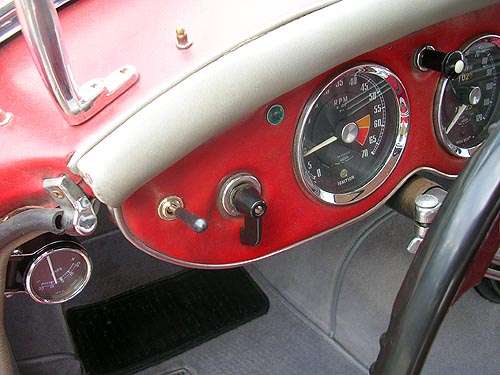
This is an item that should have been included with the car, as it was on the Triumphs and Jaguars of the 50s. An Ammeter is useful in showing the condition of the electrical charging system and whether your generator is working properly. Over the years (and several MGs) I have had about five generators/alternators fail on me without warning, and I literally didn't know until the headlights got dim or the car wouldn't start. An ammeter (or voltmeter) would have warned me long before it became a problem.
Although a voltmeter would be more useful in terms of functionality -- reading out the exact output of the battery in volts as opposed to its charge/discharge state -- British cars were not offered with voltmeters until the seventies. So the "period correct" gauge would be a LUCAS ammeter.
ADDENDUM: apparently the "Smiths" moniker actually pre-dates both Jaeger AND Lucas, having produced watches and instruments since the early 1900s, and they "branded" their gauges according to the vendor buying them. Jaeger was standard brand for Euro automobile manufacturers from the 1940s to mid-60s -- unless it was an electrical gauge (ammeter), then it had a licensed Lucas name (since Lucas was responsible for the car's electrics). During the British Leyland consolidation of the mid-60s everything was labeled "Smiths" thereafter with some exceptions (certain European cars). In the 1980s the aftermarket parts briefly became "Tudor" but now all modern replacements have reverted to the classic Smiths logo.
Here is a crude mockup of what an MGA ammeter SHOULD look like -- identical to the styling of the Fuel gauge, but with a center-weighted Discharge-to-Charge scale. Unfortunately it was never made, and aftermarket gauges will never match "exactly".
Finding a period-correct British ammeter is not easy. There are several different styles, so you can take your pick from the examples below and choose your favorite, all are from the 50s
|
|
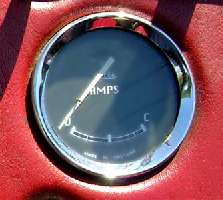
|
|
 This type is my personal favorite since the dial reads from minus to plus, and the design is very similar to the Jaeger gauges (though the font is not correct). This design is identical to the original side-illuminated full scale gauges (older design) like the Fuel and Safety gauges.
I prefer mounting it unobtrusively under the dash using an Autometer chrome mounting cup, but I've seen others use L-shaped panel brackets or fabricate their own mounting.
This type is my personal favorite since the dial reads from minus to plus, and the design is very similar to the Jaeger gauges (though the font is not correct). This design is identical to the original side-illuminated full scale gauges (older design) like the Fuel and Safety gauges.
I prefer mounting it unobtrusively under the dash using an Autometer chrome mounting cup, but I've seen others use L-shaped panel brackets or fabricate their own mounting.

Another more common LUCAS ammeter also fits well: the font lettering is a closer match although the scale increment markings are not. Rear-mounted illumination works better but does not match the side-illumination of the original gauges. This gauge also features the nice minus-to-plus scale.

Also a nice one with the "classic" open face and side illumination. Wrong color scale and needle, but the font is a near-perfect match.
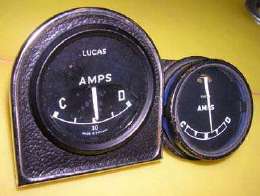
Two other styles, both from Jaguars of the 50s and 60s but still "correct" aftermarket for the MGA.
Gauge Guys sells NEW Smiths ammeters that are "near" correct. You can get them without the lightning-bolt design.
|

|
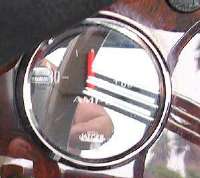
|
UPDATE: I did recently see a Jaeger ammeter on a Sunbeam Alpine. Not sure if you can make out the picture. But it has the wrong color dial needle, wrong bezel, and font lettering doesn't match the MGA style...
|
 Be very careful when hooking up an ammeter! One wrong connection or loose wire and you could have a shower of sparks in your car. Here is what Barney shared with me regarding ammeter installation, it is REQUIRED reading for anyone wishing to undertake this procedure: Be very careful when hooking up an ammeter! One wrong connection or loose wire and you could have a shower of sparks in your car. Here is what Barney shared with me regarding ammeter installation, it is REQUIRED reading for anyone wishing to undertake this procedure:
 "For a vintage ammeter you have to use heavy wire and run all of the current of everything in the car through it, except to exclude the starter motor. Click for a wiring schematic. "For a vintage ammeter you have to use heavy wire and run all of the current of everything in the car through it, except to exclude the starter motor. Click for a wiring schematic.
 "It is the fat brown wire running from the starter switch to control box terminal "A" which carries all this current, both for power draw and for charging the battery. Disconnect one end of this wire and connect the ammeter in series. This requires running the heavy current wires through the bulkhead and under the dash in the passenger compartment. Be very careful not to cause a short circuit anywhere, as this would be a direct short from battery to ground on a high current circuit (generator output included). That's what causes big sparks and fires. This is why the vintage type ammeter is not terribly popular". "It is the fat brown wire running from the starter switch to control box terminal "A" which carries all this current, both for power draw and for charging the battery. Disconnect one end of this wire and connect the ammeter in series. This requires running the heavy current wires through the bulkhead and under the dash in the passenger compartment. Be very careful not to cause a short circuit anywhere, as this would be a direct short from battery to ground on a high current circuit (generator output included). That's what causes big sparks and fires. This is why the vintage type ammeter is not terribly popular".
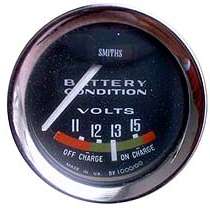
A Smiths Voltmeter is probably a better choice for monitoring your electrical system but is technically not "period-correct" since it was not made until several years after the MGA was discontinued.
|
|
